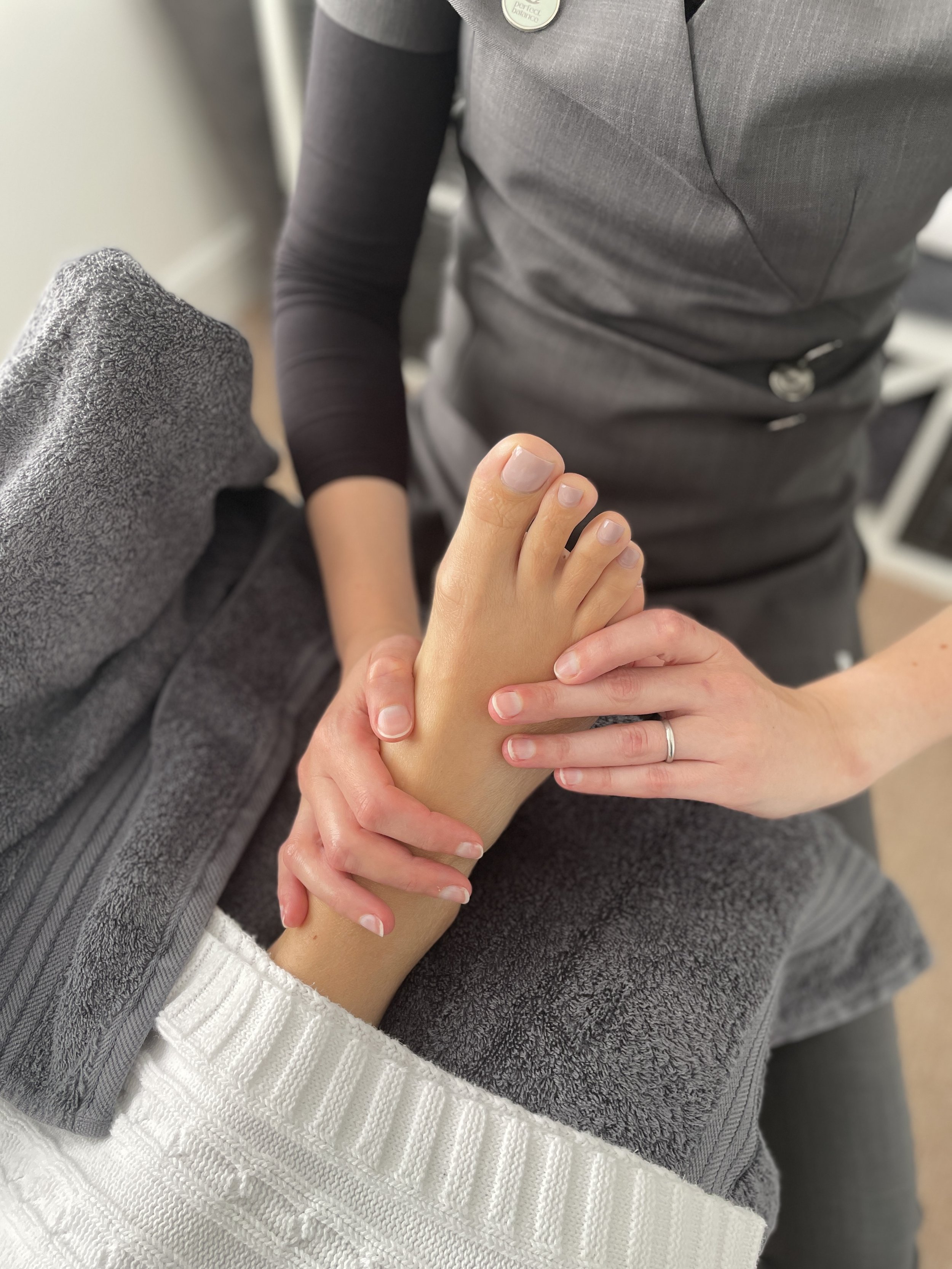
What is reflexology and how does it work?
Reflexology is a non-invasive therapeutic treatment that uses gentle pressure techniques on specific reflex points located on the feet, face, hands and ears. Reflexologists believe that these reflex points correspond to various organs, glands and systems within our body.
During a treatment varying degrees of pressure are used with our hands, fingers and thumbs to identify areas of sensitivity which are then worked on to release toxins and blockages. By doing this we enhance our natural energy flow, known as Qi or Prana, which represents the life force circulating through all living beings along pathways called meridians. Blockages in these energy pathways can lead to both mental and physical health issues and so reflexologists will aim to clear these pathways helping to restore balance and promote our body’s natural healing process.
Once toxins have been disbursed from these reflexes they will be flushed out and released back into the bloodstream to promote healing. Due to this, drinking plenty of water after a treatment is really important to support the body's natural detoxification processes and to gain maximum benefits from the session.
Reflexology is considered a complementary therapy and can be used alongside conventional medicine. For example; individuals undergoing IVF may seek out the support of reflexologists to help reduce stress, promote relaxation and enhance overall wellbeing while they are having their IVF treatments.
History & origins
Reflexology dates back to ancient civilizations, with forms of foot and hand massage practiced in China, Egypt, and India for thousands of years. The earliest evidence, around 2500 BCE, is found in Egyptian tomb paintings depicting hand and foot treatments.
Modern reflexology began in the early 20th century with Dr. William H. Fitzgerald, who introduced ‘Zone Therapy’, dividing the body into ten zones where pressure on specific points could affect corresponding areas. In the 1930s, Eunice Ingham further developed this, mapping reflex points on the feet that connect to the entire body. The ‘Ingham Method’ remains the most widely used reflexology technique today, which is what I was trained in.
The benefits of reflexology
Reflexologists do not claim to diagnose or cure. However, reflexology has demonstrated effectiveness in supporting the following:
Better sleeping patterns: The relaxation induced by reflexology can improve sleep quality and even help with insomnia. Several studies have taken place in regards to this and had scientifically proven, positive results, which is great for the reflexology community!
Easing symptoms of stress and anxiety: Reflexology helps to calm the nervous system, promoting deep relaxation helping to reduce symptoms of stress and anxiety.
Improving circulation: By stimulating specific reflex points reflexology can improve blood flow and oxygen supply throughout the body.
Helping with pain relief: Reflexology can help alleviate pain by triggering the body’s natural pain management systems.
Boosted immune system: By encouraging balance within the body, reflexology supports the immune system and could even help the body fight off common illness, like a cold, more effectively.
Hormonal balance: Regular treatments can aid in regulating hormones which is particularly useful for fertility support, menstrual issues or menopause.
Digestive health: By stimulating the digestive system reflexes, reflexology can help potentially ease symptoms of constipation, bloating and indigestion.
Detoxification: Promoting the body’s natural detox processes and aiding in removing toxins.
Mental Clarity: Helping to reduce mental fatigue, increase focus, and improve overall mood.
Foot Reflexology: The feet have over 7,000 nerve endings, reflexology can help in boosting nerve function and sensitivity.
Facial Reflexology: Treating the face can sometimes have a better outcoming when relieving chronic sinus congestion as well as symptoms of bruxism and bell's palsy.
These benefits contribute to improving overall wellbeing by addressing both physical ailments and mental health.

Who can have reflexology?
Reflexology is generally safe for most people and can be beneficial for individuals across various age groups and health conditions.
However, here some common contraindications for reflexology, meaning situations where it may not be safe or advisable:
-
Infectious Foot Conditions: Conditions like athlete's foot, warts, or fungal infections can worsen with treatment.
Open Wounds or Sores: Any cuts, ulcers, or injuries on the feet may be aggravated by reflexology.
Blood Clots or Deep Vein Thrombosis (DVT): Reflexology could dislodge clots, posing serious health risks.
Pregnancy (First Trimester): Although a highly qualified reflexologist will know the reflex points to avoid during the first trimester, it’s advised to leave pregnancy reflexology until the second trimester.
Severe Circulatory Disorders: Conditions like phlebitis or severe varicose veins might be exacerbated.
Recent Surgery or Injury: Reflexology should be avoided after a recent operation or injury and can be resumed after your physician has discharged you or said it’s ok to have reflexology again. This is generally around 6 weeks after.
Heart Conditions: People with uncontrolled heart conditions should consult a doctor before receiving reflexology.
Diabetes: Reflexology should be performed cautiously on individuals with diabetes, especially if they have neuropathy or poor circulation. If you have diabetes it’s important to make your reflexologist aware of this during the initial consultation.
Fever or Acute Illness: It’s not recommended as it may overstimulate the body causing a healing crisis reaction. Treatments should be cancelled/rescheduled until you have fully recovered.
Osteoporosis or Fragile Bones: Extra care will need to be taken during a treatment to avoid applying too much pressure in those with osteoporosis or other bone disorders. If you have either condition it’s important to make your reflexologist aware of this during the initial consultation.
Epilepsy: Reflexology might stimulate the nervous system in ways that could trigger a seizure, so caution is advised and you should consult your doctor ahead of a treatment.
Cancer Treatments: Reflexology may interfere with certain treatments or be too stimulating, so it should only be performed with your doctor's consent.
If you would like a treatment, but unsure whether reflexology is suitable for you, why not book in for a free video consultation.
There is no commitment, pressure or obligation to schedule a treatment.

